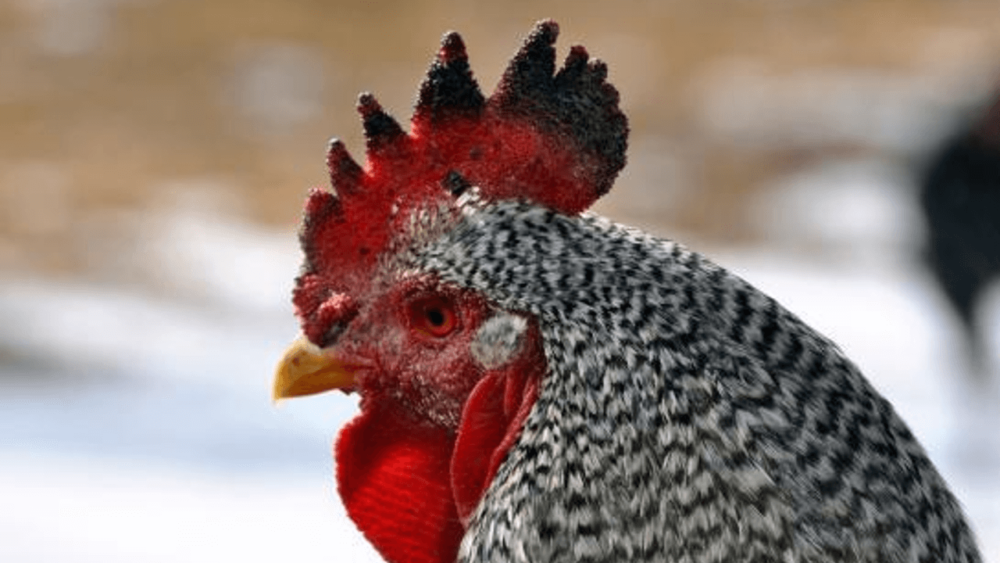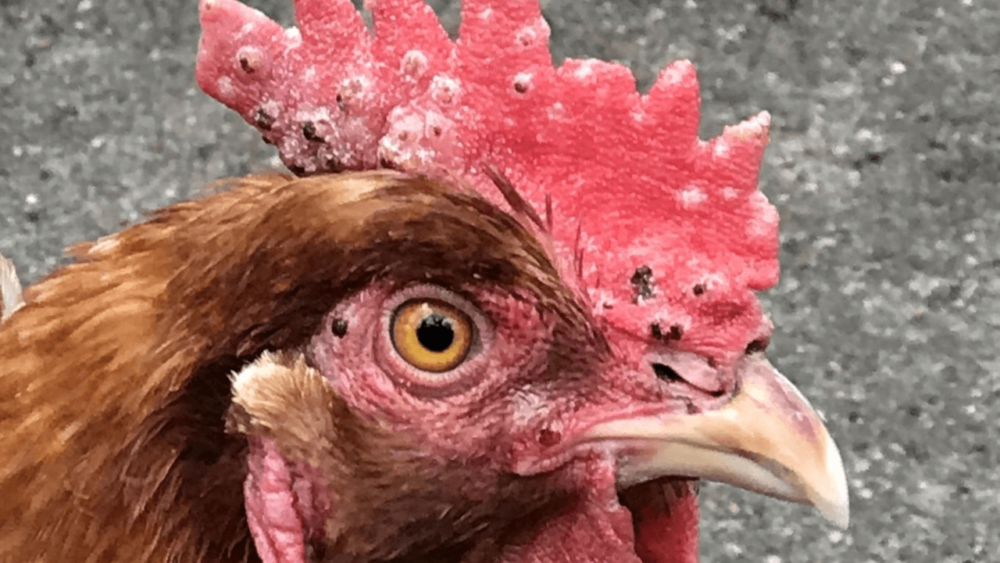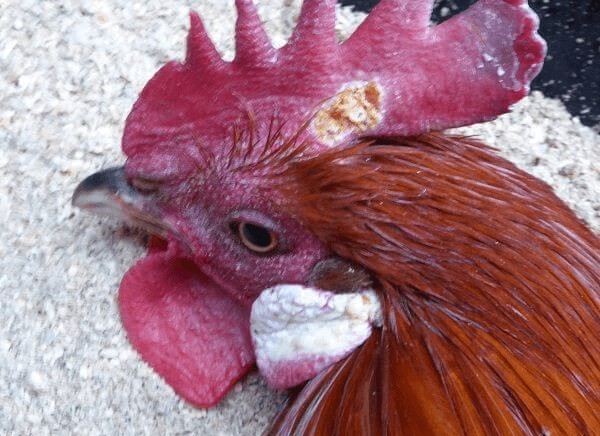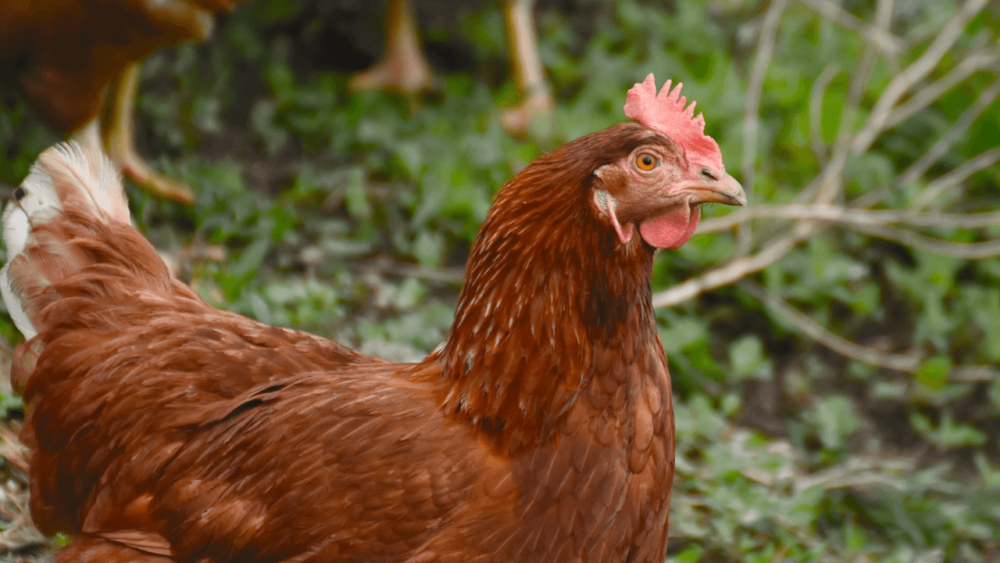If you see a person looking red, green, or grey in the face, you immediately know something’s wrong. The same goes for a chicken, but their combs give the game away. The wattles may also change color, but the comb gives us the best indication of a chicken’s health feeling.
When a chicken’s comb starts looking paler than usual or turns a different color, it often means there’s something’s amiss.
Why has my chicken’s comb gone pale or turned blue? A chicken’s pale comb is usually a sign that your chicken has either anemia or a lack of oxygen. This can happen from too many internal parasites, liver or heart problems, which can cause the comb to turn blue.
| Color of the Comb | Potential Causes |
| Pale Pink, Whitish |
|
| White Comb |
|
| Black Comb (Dark Purple) |
|
| Yellow Comb |
|
If your chicken’s comb is pale, it’s critical to understand the importance of the comb so that you know what other signs to watch for. This article will help you to identify the cause of a pale comb. VA note: Possibly add a chart that outlines the changes in color and possible symptoms.
The Three Functions Of A Chicken’s Comb
A throwback from its dinosaur ancestors, the chicken’s comb’s primary function is reproduction. Studies show that the larger the hen’s comb, the more attention – and sperm – she gets from the dominant roosters.
Researchers at Linköping University in Sweden also discovered a correlation between the weight of a hen’s comb and her bone density and egg production. The heavier the comb, the more productive the hen, they concluded.
It’s not all about reproduction, either. Chickens are homeothermic or warm-blooded. As such, they can regulate their body temperatures. They don’t sweat but use their combs, wattles, and feathers to maintain a healthy temperature range.
Fluffing out the feathers is a way of keeping warm. Increasing the flow of blood to the comb and wattle, on the other hand, enables the chicken to lose heat.
Mediterranean chicken breeds, like the Andalusian and Leghorn, have developed larger combs to increase this ability to dissipate heat.
Conditions That Cause A Chicken’s Comb To Go Pale, Turn Black or Purple
A rooster experiencing a surge in testosterone may reflect this in a darkening of his comb. As the blood flow increases, more blood is pushed into the comb, causing it to appear darker than normal.
If the comb is still plump in appearance and firm to the touch, there’s probably nothing to worry about.
If the comb becomes dry or flaky as well as discolored, however, your chicken could be suffering from any of the following conditions:
#1 Molting Chickens Can Cause a Pale Comb
A pale or even blue comb doesn’t always mean there’s something wrong with the chicken. Some molting hens develop a slightly paler comb but will return to their usual vibrant red once the molt is complete.
Check out How to Care for You Molting Chicken.
#2 Parasites Affect Chicken Health and Comb Color
Internal parasites put the chicken’s system under a lot of pressure. As she loses her health, her comb will become dry and pale. She may also lose weight, become listless, and produce abnormal droppings.
You can prevent internal parasites by using diatomaceous earth in their bedding. Sprinkle it over their bedding, and use either the deep litter layer or change bedding frequently. Add DE to their food at a 2% dose. Keep the coop clean. Provide your chickens with a balanced diet and plenty of freshwater.
Rotating your flock between pastures can help mitigate worm issues. Probiotics and apple cider vinegar added to the water can also help their systems combat parasites.
Deworming your chickens becomes critical if the worm load is high. But it’s important to do a fecal test to determine what type of parasite your flock has and how serious it is. Treating too frequently or the wrong kind can cause issues. Most types of dewormers only treat a specific type of parasite.
And, using commercial dewormers frequently can develop resistant worms. It’s a problem faced by a lot of animal raisers.
Other Signs of Worms:
- Pale comb and wattles
- Lethargy or weakness
- Ruffled feathers
- Weight loss
- Runny or foamy stool
#3 Anaemia: Pale Comb
Chickens suffer from three different types of anemia: blood-loss-associated anemia, hemolytic anemia, and depression-associated anemia. A pale comb and wattle are associated with all three.
Symptoms of Anaemia include:
- Pale Comb
- Lethargy
- Weight loss
- Weakness
- A change in feather color.
All types of anemia are potentially fatal.
If you have an anemic chicken, separate her from the rest of the flock and isolate her somewhere warm and quiet. Make sure she has enough food and water. Keep stress to a minimum and call a vet.
Check for mites if you don’t have access to a vet that treats birds. Mites can cause a chicken to go anemic. Add food-grade diatomaceous earth to their food and bedding. And, feed your chicken small pieces of raw meat to help their iron levels go up. Scraps of your meat waste work well, but make sure it isn’t salted.
#4 Heat Stress: Pale Comb
Chickens can only regulate their temperatures so much. When the ambient temperature soars and the humidity rises, chickens can get heat stress.
Along with a pale comb, a chicken with heat stress will also develop the following symptoms:
- Labored breathing
- Lethargy
- Diarrhea
- Convulsions
They also lift their wings away from their bodies in an attempt to cool down. You can prevent heat stress by giving your chickens access to shade and water on hot days.
If you see a chicken with suspected heatstroke, give it electrolytes for several hours before offering clean water. You may need to administer the electrolytes repeatedly before the chicken makes a full recovery.
Check out How to Care For Chickens During Hot Temperatures.
#5 Dehydration: Discolored Comb
Dehydration and heat exhaustion often go hand in hand. The symptoms are also very similar. While you can treat it with electrolytes, preventing it is better for your flock’s health.
According to one study, chickens consume twice as much water as food. That means the average hen needs between 0.5 and 1l of water per day. In hot weather, larger breeds may need even more.
Make sure your chickens have plenty of fresh, cool water. It helps to have more than one watering station so that hens lower on the pecking order can still access water. Sometimes higher-up hens will prevent less dominant hens from water.
Dehydration can also increase the occurrences of frostbite during the winter. Chickens need plenty of water to regulate their body heat.
#6 Frostbite: White or Black Comb
As winter approaches, watch out for signs of frostbite.
The comb will initially become white but warm and soft to the touch. Check out Frostbite in Chickens: Avoiding it and Treating it.
As the frostbite progresses, the comb becomes hard and starts swelling. You may also see blisters develop on the surface of the comb. In the advanced stages of frostbite, the comb will turn completely black. This is a result of necrosis, during which the tissue and nerves die off.
To prevent any permanent nerve or tissue damage, you need to treat frostbite early. Gradually warm the affected area using a lukewarm flannel. Warm the flannel up gradually until it’s around 105°F and 107°F. This is a chicken’s normal temperature.
Ensure the chicken is drinking regularly and offer electrolytes and vitamins to boost the healing process.
Although all breeds of chicken can develop frostbite, those with large, upright combs like the Leghorn are likely to be more susceptible to it than those with small, pea combs, like the Brahma and Buckeye. See Best Chicken Breeds for Extreme Cold.

#7 Lack of Oxygen Causes A Black Comb
Unless a Silkie’s wearing it, a black or purplish-colored comb is cause for concern. As we noted earlier, frostbite can cause a comb to go completely black.
Lower oxygen can cause a chicken’s comb to go black. This can be caused by a respiratory illness, liver or heart issues, or choking.
First, check to make sure your chicken can breathe and doesn’t have a blockage in the throat. Check for other signs of illness, such as lethargy.
Suppose the liver or heart has issues, blood circulation to the comb, and wattles. Eventually, the circulation to the feet also decreases. This can cause a darkening along the edges that eventually grow as your chicken’s condition deteriorates. Unfortunately, liver and heart problems are not treatable.
A black comb can also be a sign
- Lack of oxygen
- Respiratory problems
- Poor circulation
- Heart problems
- Liver issues
#8 Respiratory Problems Cause Purple, Blue, or Black Combs and Wattles
Over-crowded, dusty coops play havoc with the chicken’s fragile respiratory system, making the problem of the black comb more likely.
#9 Fowl Cholera Causes Purple Wattles
Fowl cholera can also cause the comb and wattle to turn purple. Other symptoms include coughing, loss of appetite, and swollen joints.
Caused by bacteria, fowl cholera requires antibiotics. However, the risk of reinfection is high as the bacteria may still be present in the ground. Using disinfectants to clean out the coop and surrounding areas can help reduce that risk.
Symptoms of Fowl Cholera:
- Purple spots on the wattle
- Swollen joints
- Diarrhea
- Loss of appetite
- Coughing
Pullets are more likely to Fowl Cholera. The bacteria can survive in the soil for a long time. As a result, even after antibiotics are finished, your chickens can get it again from the soil. Isolate any sick chickens as soon as you identify them.
#10 Fowl Pox: Black Spotted Comb
In the warmer months, black spots can indicate fowl pox, especially if they start forming scabs.
Fowl pox is relatively common and highly infectious. It affects all the featherless areas of the chicken, including their combs, eyes, and wattles. Although there is no known treatment for fowl pox, many chickens recover.
Fowlpox is a virus that affects chickens of all ages. It’s spread through contact with sick chickens and mosquitoes. Fowlpox creates scabs on the wattles and comb (dry version). It can also appear inside your chicken’s mouth and cause breathing issues (wet version).
Fowl Pox is only preventable through vaccination which is usually only used for commercial hens. Backyard hens are not as likely to catch this disease unless you are in an area with an infestation or near commercial poultry farms. Wild turkeys can also carry fowl pox and spread it to your flock via mosquitoes.
Chickens with fowl pox generally recover. It takes between 1-3 weeks for an exposed chicken to come down with it. Fowlpox doesn’t pass to people or pass to the eggs.
Sighs of Fowl Pox:
- Lethargy
- Decreased appetite
- White sores on unfeathered skin that turn into black pinhead scabs
- Inflamed and red eyes
- Flat yellow lesions in the mouth
- Round scabs on the comb

#11 Fungal Infections: Yellow or Black Comb
Fungal infections also cause spots on the combs. These are usually white and round, although some fungi cause yellow or black masses to develop. Many chicken owners apply apple cider vinegar to the combs to treat such problems. If the symptoms persist, your vet will probably prescribe a course of antibiotics.
Yellow Chicken Comb
If your chicken’s comb is yellow, it is usually a sign of organ problems, changing food or seasons, or a viral disease. Some chickens can show signs of organ issues if their feed changes (causing extra stress on their digestive organs).
Other hens have a slightly yellow-tinted comb when they stop laying eggs during the year. Watch your chickens for other signs of distress. Make sure your flock is getting enough nutrition in their diet. Check the rest of your hen for other symptoms. Look for scabs, lesions, and sores in the vent, waddles, and mouth.

How To Prevent Common Comb Problems
Getting hen-pecked is no laughing matter. Chickens can cause one another injury and leave one another’s comb in tatters if you don’t keep on top of things. Although pecking is a natural part of life in the coop, some hens are just bullies.
You can prevent such behavior by removing the bullies from the coop, but that’s not always feasible. Providing enough space, food, and water is key to a happy flock. You can also try distracting the dominant hens by giving them something else to peck at, like a log or a snack block.
Covering an injured comb with Vaseline may also help deter the bullies and give it time to heal.
The best way to keep your chickens and their combs healthy is to provide them with a clean, well-ventilated environment. Giving them a balanced diet and plenty of fresh, clean water will also help keep common comb problems at bay.
Vaccinations can also help prevent some of the problems associated with a discolored comb, as can a regular deworming schedule.
The 9 Different Types of Chicken Comb
With hundreds of different breeds of chickens, it shouldn’t surprise you to learn that there are nine distinct types of chicken comb. Knowing which one your chickens should be wearing will give you a clearer idea of what a healthy comb should look like.
#1 Single Comb
The single comb is easily recognized and associated with popular breeds like the Rhode Island Red and Faverolle. Usually red, it stands upright and has obvious points at the peak.
Caption: An example of a healthy single comb
#2 Buttercup Comb
You may not be familiar with this unusual variation on the single comb as it appears on only one breed – the increasingly rare Sicilian Buttercup. It resembles two single combs that have joined together to form a crown.
#3 Pea Comb
Hardy breeds like the Brahma and Ameraucana have small, pea-shaped combs that help reduce the amount of heat radiation and keep them warm in cooler climates. The pea comb sits close to the chicken’s head and has three textured ridges along the top.
#4 Rose Comb
Like the pea comb, the rose is comparatively small and flat. It appears almost to hug the chicken’s head. Wyandottes and Dominiques both have rose combs, distinguished by the spike at the back. As the rose comb is worn so close to the head, these chicken breeds are less susceptible to frostbite.
#5 Strawberry Comb
This comb resembles a strawberry and extends over the chicken’s beak. They’re not particularly common but a feature of the unusually tall Malay chickens.
#6 Cushion Comb
A smaller version of the strawberry, this type of comb sits on top of the chicken’s head like a cushion. The Chantecler sports a cushion comb, as do some bantam breeds.
#7 Walnut Comb
This strange-looking comb resembles a walnut with its lumpy, round appearance. The popular Silkie chicken has a walnut comb, but it’s not always visible underneath all their fluffy plumage.
#8 Carnation Comb
Only two breeds of chicken have a carnation comb. The Empordanesa and the Penedesenca’s combs are similar to the single comb but feature additional spikes that give it a crown-like appearance.
#9 V Comb
This unusual comb is worn only by a few rare chicken breeds, namely the Crèvecœur, La Flèche, and Sultan. The two upright spikes give these hens something of a devilish appearance.
Not only do chicken combs come in a variety of shapes and sizes, but they also vary in color. Many Silkies have purple or even black combs. However, a red comb is the norm, and any changes could signal a problem.
Conclusion
Hormonal changes can affect the color of a hen or rooster’s comb to some extent.
However, a pale, white, purple, or black comb could give you an advanced warning of an underlying health problem. Most of the issues that cause combs to change color are treatable, especially if caught early.
My Favorite Chicken and Duck Supplies
This list contains affiliate products. Affiliate products do not cost more but helps to support BestFarmAnimals and our goal to provide farm animal owners with accurate and helpful information.
Manna Pro Oyster Shell keeps eggs strong. Before I gave my chickens oyster shell, I had the oddest eggs, many with weak and irregular shells. Now, I don’t have an issue.
Layer Feed by Manna Pro. I like pellets rather than crumbles as my chickens eat them better and less gets wasted or scavenged by rodents. A good layer feed makes the difference in hens laying many more eggs.
My chickens love this mealworm treat, which gives added protein, something that’s great during molting and winter months.
There are many ways to feed and water your chickens. I like this food and water setup the best because it reduces waste, saves me time feeding and watering, and keeps the food fresh longer. Except, in the winter, I use a heated waterer. The only problem is the heated waterers need to be replaced every few years.
I love this chicken veggie hanger. It makes it easy to give your chickens produce from the garden and keep them occupied in the winter with a fresh head of lettuce.
These chicken toys are a hoot! They will help curb bullying and keep your chickens active, especially in the winter when hens tend to get more lethargic.




